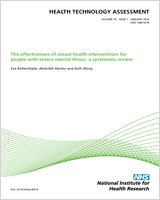Included under terms of UK Non-commercial Government License.
NCBI Bookshelf. A service of the National Library of Medicine, National Institutes of Health.
Bergman H, Walker DM, Nikolakopoulou A, et al. Systematic review of interventions for treating or preventing antipsychotic-induced tardive dyskinesia. Southampton (UK): NIHR Journals Library; 2017 Aug. (Health Technology Assessment, No. 21.43.)

Systematic review of interventions for treating or preventing antipsychotic-induced tardive dyskinesia.
Show detailsWe intended to synthesise available evidence from treatment options of interest using a NMA model.155–157 However, the sparseness of the existing evidence imposed important barriers in the analysis rendering the presentation of NMA results as our main analysis impractical. In particular, comparisons were typically informed by very few studies, and many studies had few or even zero events. Analysing and interpreting few data can be particularly challenging, and simulation studies have shown that many of the most commonly used meta-analytic methods produce biased estimates and misleading conclusions when events are rare.158,159 Challenges in the analysis of few data include the difficulty of justifying the use of distributional approximations to statistics of interest and the potential risk of small studies including unrepresentative populations.159,160
Use of NMA can benefit the evidence synthesis of few data by borrowing strength across treatment comparisons and gaining information through the contribution of indirect evidence. Moreover, sharing parameters across the entire network can provide information on their inference; here, we assumed a common heterogeneity parameter across all treatment comparisons. Although the assumption of a common heterogeneity is expected to hold in this setting, formal investigation of between-study variations is limited by the sparseness of the data. Despite efforts to strengthen the evidence body and sharing parameters across networks, analysing and interpreting NMA results under sparseness was challenging; results of NMA for the outcomes ‘no clinical improvement of TD symptoms’ and ‘total discontinuation rates’ are presented in Appendix 4. Network effects were almost identical to their pairwise meta-analysis counterparts when direct evidence existed; any differences are attributed to the estimation of heterogeneity. When direct evidence was absent, indirect estimates were highly imprecise, failing to produce useful summaries on the relative effectiveness of the interventions of interest and consequently to provide interpretable results to be used for decision-making. Moreover, no closed loops of evidence were formed in the network for the primary outcome and only one existed for total discontinuation rates, making it impossible to evaluate the validity of the consistency assumption. The interventions of interest that were set to be on the priority list did not form a connected network that could be analysed at once; this further limited the value of performing NMA and precluded us from presenting it as our main analysis.
Despite the barriers that lack of sufficient research data may impose, decisions often need to rely on few data. Thus, exploration of possible ways in which inferences could be made based on a limited evidence base would be useful. Use of external evidence, both eliciting expert opinions and using observational data, has been considered elsewhere.160 The presence of few data, along with the associated highly imprecise NMA effects, highlights the uncertainty surrounding the relative effectiveness between alternative treatment options for TD and underlines the need for further research to be conducted. Future studies should be planned (see Chapter 8, Recommendations for research) to enrich the existing evidence base and, by making the synthesis of data in a NMA model sensible, to enlighten the relative effectiveness between available treatment options.
Several methods, tailored to outcomes with very low frequency, have been developed.161–163 Rücker et al.161 proposed the arcsine difference as an alternative effect size measure that enables such studies to be included in a meta-analysis. Despite its advantages, the arcsine method provides an effect size that is difficult to interpret and is poorly understood by clinicians.
- Part C: results of the network meta-analysis - Systematic review of intervention...Part C: results of the network meta-analysis - Systematic review of interventions for treating or preventing antipsychotic-induced tardive dyskinesia
- SRX23842559 (1)SRA
- JGI_CAAL21092.fwd NIH_XGC_tropBrn4 Xenopus tropicalis cDNA clone IMAGE:7672772 5...JGI_CAAL21092.fwd NIH_XGC_tropBrn4 Xenopus tropicalis cDNA clone IMAGE:7672772 5', mRNA sequencegi|58621393|gnl|dbEST|27588968|gb|C 49.1|Nucleotide
- nuclear receptor subfamily 2, group F, member 6, isoform CRA_c, partial [Mus mus...nuclear receptor subfamily 2, group F, member 6, isoform CRA_c, partial [Mus musculus]gi|148696965|gb|EDL28912.1||gnl|WGS |mCP93364Protein
- Homo sapiens X-ray repair cross complementing 4 (XRCC4), RefSeqGene on chromosom...Homo sapiens X-ray repair cross complementing 4 (XRCC4), RefSeqGene on chromosome 5gi|2310180345|ref|NG_047086.2|Nucleotide
Your browsing activity is empty.
Activity recording is turned off.
See more...